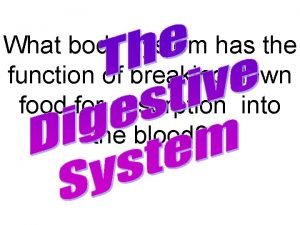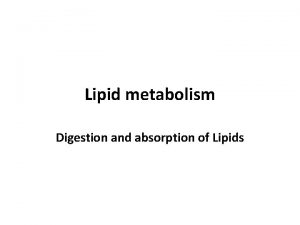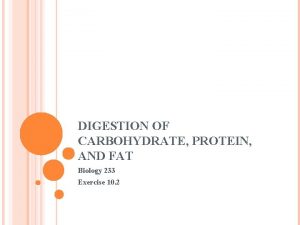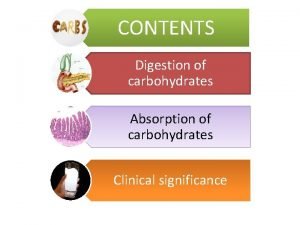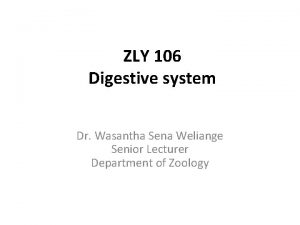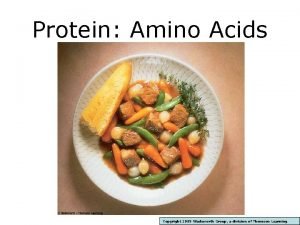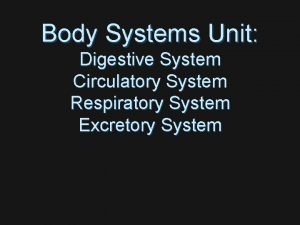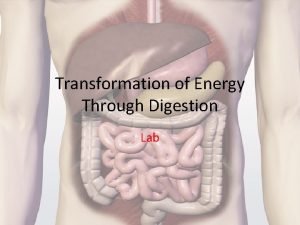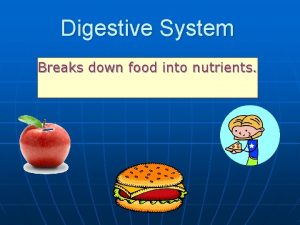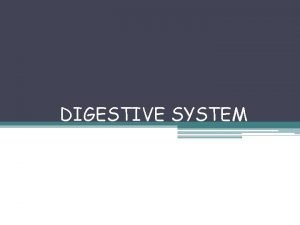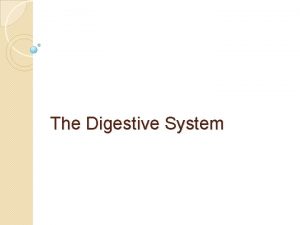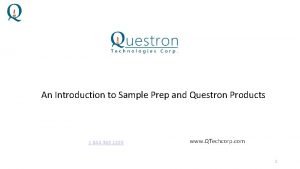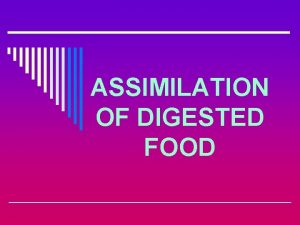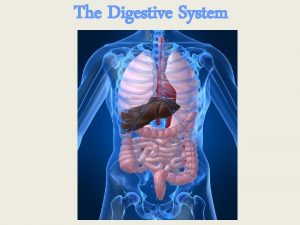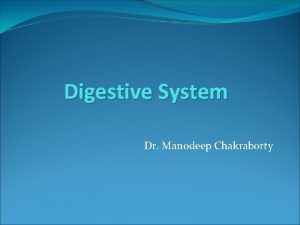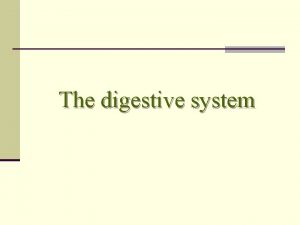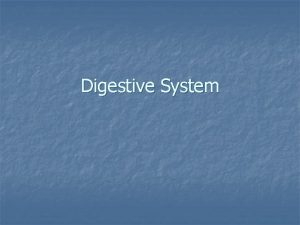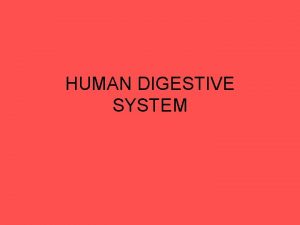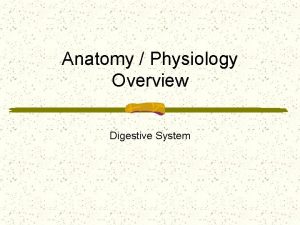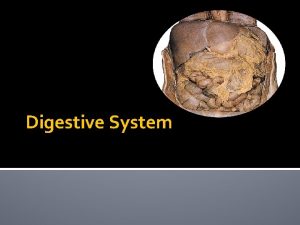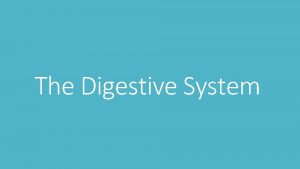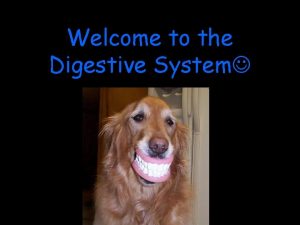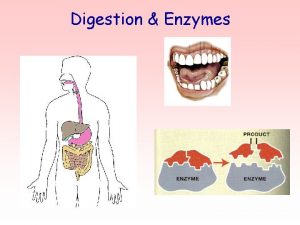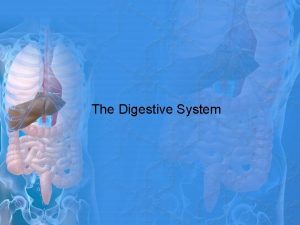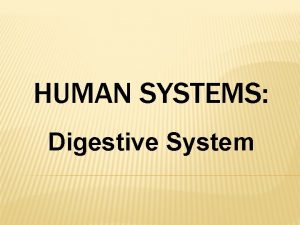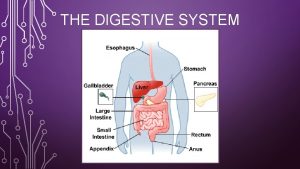The Digestive System How is food digested Digestion



























- Slides: 27

The Digestive System

How is food digested? Digestion involves: • • Breaking down of food into smaller pieces The mixing of food Movement through the digestive tract Chemical breakdown of the large molecules of food into smaller molecules.

Describe the digestive system • The digestive tract is a series of hollow organs joined in a tube from the mouth to the outside of the body. Food passes through the digestive tract. • Accessory organs include the liver, gall bladder, and pancreas. Food does not pass through these organs.

Identify the organs of the digestive system

MOUTH • Teeth bite off and chew food into a soft pulp that is easy to swallow. • Chewing mixes the food with saliva, from salivary glands around the mouth and face, to make it moist and easy to swallow.

Why is saliva important? • Enzymes( proteins that help break down food) in the saliva begin digestion of carbohydrates.

Esophagus

Esophagus • A muscular tube • Job: It takes food from the throat and pushes it down through the neck, and into the stomach. • It moves food by waves of muscle contraction called peristalsis.

Stomach

Stomach • Thick muscles in its wall • Job: These contract to mash the food into a water soup called chyme. • The stomach lining produces strong digestive juices.

Why are the digestive juices in the stomach important? • These create chemical reactions in the stomach, breaking down and dissolving its nutrients.

Small Intestine • This part of the digestive tract is narrow, but very long - about 20 feet. • Enzymes continue the chemical reactions on the food.

Small Intestine

Small Intestine • Job: The nutrients are broken down small enough to pass through the lining of the small intestine, and into the blood (diffusion). • Nutrients are carried away to the liver and other body parts to be processed, stored and distributed.

Large Intestine

Large Intestine • Useful substances that were not absorbed in the small intestine, such as spare water and body minerals, are absorbed through the walls of the large intestine, back into the blood.

Large Intestine • The remains are formed into brown, semi-solid feces, ready to be removed from the body

Rectum and Anus • The end of the large intestine and the next part of the tract, the rectum, store the feces. • Feces are finally squeezed through a ring of muscle, the anus, and out of the body.

Rectum and Anus

The Accessory Organs 1) Pancreas 2) Liver 3) Gallbladder *Not directly involved in digestion

Pancreas

Pancreas • Job: Makes digestive juices called enzymes which help to digest food further as it enters the small intestines.

Gall Bladder • A small baglike part under the liver. • It stores a fluid called bile, which is made in the liver.

Gall Bladder • As food from a meal enters the small intestine, bile flows from the gall bladder along the bile duct into the intestine. • It helps to digest fatty foods and also contains wastes for removal.

Liver • Blood from the intestines enter the liver, carrying nutrients, vitamins and minerals, and other products from digestion. Jobs of the liver: 1) Glycogen storage, 2) Decomposition of red blood cells 3) Making proteins that are part of the blood 4) Hormone production 5) Detoxification.

How is water involved in digestion? • Most of the nutrients in your body can't be used unless they are carried in a solution. This means that they have to be dissolved in water. • In cells, chemical reactions take place in solutions.

How is water involved in digestion? • Most of the material absorbed from the cavity of the small intestine is water in which salt is dissolved. • The salt and water come from the food and liquid we swallow and the juices secreted by the many digestive glands.
 Mechanical vs chemical digestion venn diagram
Mechanical vs chemical digestion venn diagram Digestive system circulatory system and respiratory system
Digestive system circulatory system and respiratory system Mixed micelle
Mixed micelle Enzyme carbohydrate
Enzyme carbohydrate Digestion of carbohydrates
Digestion of carbohydrates Wasantha sena weliange
Wasantha sena weliange How are macromolecules separated or digested
How are macromolecules separated or digested Where is protein digested
Where is protein digested Major function of digestive system
Major function of digestive system Path of food from mouth to anus
Path of food from mouth to anus Nervous system and digestive system
Nervous system and digestive system Unit 2 food food food
Unit 2 food food food Food chain food chain food chain
Food chain food chain food chain Energy transformation digestion
Energy transformation digestion Digestion of food in stomach
Digestion of food in stomach Digestion of carbohydrates ppt
Digestion of carbohydrates ppt 4 functions of the stomach
4 functions of the stomach Questron microwave digestion system
Questron microwave digestion system Photo of human digestive system
Photo of human digestive system Hát kết hợp bộ gõ cơ thể
Hát kết hợp bộ gõ cơ thể Frameset trong html5
Frameset trong html5 Bổ thể
Bổ thể Tỉ lệ cơ thể trẻ em
Tỉ lệ cơ thể trẻ em Voi kéo gỗ như thế nào
Voi kéo gỗ như thế nào Tư thế worm breton là gì
Tư thế worm breton là gì Bài hát chúa yêu trần thế alleluia
Bài hát chúa yêu trần thế alleluia Môn thể thao bắt đầu bằng từ đua
Môn thể thao bắt đầu bằng từ đua Thế nào là hệ số cao nhất
Thế nào là hệ số cao nhất
